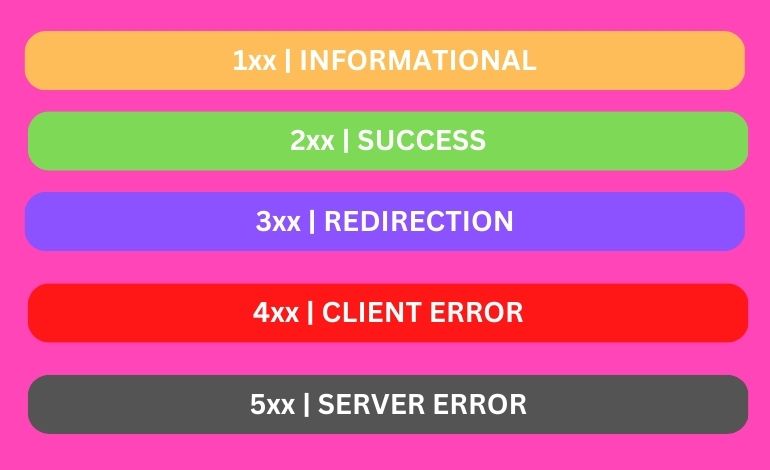We’re sure that by now you’ve probably been faced with a 404- Page not found error code at least once in your lifetime. If you’re a developer knowing what these three-digit codes mean will help you easily modify your website content and help you get rank better in terms of SEO rankings.
While demystifying HTTP Response status codes can prove to be a painful task, we’ve tried to explain it in layman’s terms through this blog. We’ve kept the blog crisp and informative so you don’t need to navigate through several sites just to know about the next steps you need to implement whenever you are faced with an HTTP status code in the future.
So let’s start with the basics first,
What exactly is an HTTP status code?
An HTTP status code is a three-digit response code that can be enabled by a user upon sending a request to the respective browser. Various HTTP status codes like 301-Moved permanently, 400-Bad request, 503-Service unavailable, and many more let the user know if there is any problem between the server and the browser.
Why are HTTP status codes even required?
An HTTP status code can help the user to eliminate the unnecessary bounce rates of their potential customer. This becomes of utmost importance to several business owners. It even helps in the improvement of the search engine result as well.
What are the various types of HTTP status codes?
HTTP status codes contain a whole list of HTTP status codes that you surely need to take a look at.
We’ve classified these HTTP status codes under 5 major groups:
Group 1xx- Informative!
100, 101, and 102 are the HTTP status codes included in this group.
100- Continue
We’re sure that would’ve probably guessed this through the term stating ‘continue’. This HTTP response code portrays that the client needs to continue with his connection request.
101- Switching protocols
In this status code, the server is ready to switch protocols however, this should only be done when there is an actual advantage in switching over.
102- Processing
Also known as WebDAV, this method is used to indicate to the client that the server is still processing. While the response has not been submitted yet, an interim response gets sent to the browser.
Group 2xx- Success!
Through these HTTP response codes, you’ll be able to know if your request was successful or not.
200- Ok
When both your request and result become successful, it usually comes under this HTTP status code. The example of Get, Head, Post, and Trace is usually considered under this category.
201- Created
A new resource is usually created during the execution of this request. An example of a Post or Put request can be taken up for instance.
204- No Content
While the server does fulfill the request it may not return an entity body and instead end up showing updated or entirely new information. Try to not include a message body or change your document view in a 204 HTTP response code.
While you need to take a look at the above-mentioned HTTP status codes there are also other status codes like 202, 203, 205, 206, 207, 208, 226, and several other HTTP codes in this list.
Group 3xx- Redirection!
The client gets redirected to a completely new resource through this HTTP response code.
301- Moved Permanently
301 HTTP status code helps in redirecting the user to a completely new URL location through the use of a location header. Since this will be the new permanent location, this and all future requests will get redirected to the new URL.
302- Found
This HTTP status code is used to move the URL temporarily. A location header gets used in this HTTP status code like the above one. This location header will be used to revert the URL in future upcoming requests.
304- Not Modified
This HTTP status code makes use of its browser to enable the use of its cached data of the requested resource. It is used when the client is performing a GET request and the access gets permitted but no modification has been implemented in the document.
More HTTP status codes like 300, 303, 305, 306, 307, and 308 also exist but we’ve discussed all the important HTTP status codes that you must necessarily know about.
4xx- Client Error!
When a code starting with this number gets displayed, it usually indicates that some kind of error has occurred.
400- Bad request
The request itself submitted by a client is invalid which gets highlighted through this HTTP error code. Try to modify your search request and retry sending your request to the server.
401- Unauthorized
A user authentication process becomes quite essential in this request. When the authentication process does not get completed this HTTP error code will get displayed on your browser.
403- Forbidden
Even if you follow the process of authentication for this HTTP error code, the client still won’t be able to access the requested resource. This HTTP error truly keeps the client’s access hidden due to the server’s refusal function.
404- Not Found
In simple terms, it indicates that the requested source code simply does not exist. No perfect estimation of whether this condition is temporary or permanent can be estimated. This HTTP status code of not found or permanently gone happens when the server understands that the old resource is no longer available and has no address he can forward as well. No exact reason will be stated for the use of this HTTP status code. This HTTP error code also gets used when there is an HTTP 401 or 403 error code.
405- Method not allowed
When a request method does not get supported by a resource this HTTP source code usually gets displayed on the user’s screen. An example of using Get on a form that requires representation in the form of Post can be taken up for this HTTP error code.
409- Conflict
This HTTP error code usually arrives when a conflict with the given resource takes place. In most cases, the client can resolve and resubmit the request. Information regarding the source of conflict gets included in the response body. Put requests are more likely to display this HTTP error code.
413- Request entity too large
When a request size is larger than the server is able to handle is made to be processed this 413 error gets displayed on the user’s screen. See whether the condition is temporary, and if it isn’t, you could maybe try again later. In this error, the system is usually not able to process large quantities of data and hence displays the code mentioned above.
414- Request-URL too long
When an HTTP status code that consists of a URL too long than a user can handle gets assigned to the server there’s a chance that it can either take too long to process the data or may not do it at all. Although it is a rare occurrence, it can be seen in a case in which a Post request gets converted to a Get one. This can also take place when your URL is under any form of cyber attack, so stay aware and avoid any case of possible manipulation.
Along with this 15 other status codes also form a part of this list which contain HTTP status codes like 415, 416, 417, 418, 420, and several others.
5xx- Server Error
Errors related to the working of your server will get displayed in this category.
500- Internal Server Error
Whenever an error relating to the internal working of your server takes place, this is the first error message that would get displayed on your screen.
503- Service unavailable
This is a temporary condition that can be faced by your server as it is unable to process any of your requests. This could either be due to maintenance, overloading, or the result of any previous action that you’ve performed.
After reading this article, you likely understand the basics of how HTTP status codes work. However, it is also important to ensure that your browser is compatible with these HTTP response codes. New-age browsers like Chrome and Edge are some good options that you can surely rely upon. Browsers like Firefox, Opera, and Safari don’t seem to work well with status codes like 103 status code and hence could be avoided.









